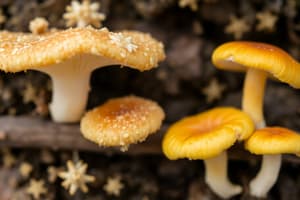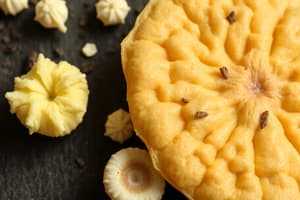Podcast
Questions and Answers
What is the method of reproduction through which some fungi produce daughter cells?
What is the method of reproduction through which some fungi produce daughter cells?
- Fragmentation
- Fission
- Conjugation
- Budding (correct)
In what type of environments are moulds typically found?
In what type of environments are moulds typically found?
- Damp, dark, or humid areas (correct)
- Clean and sterile conditions
- Dry, open areas
- Frozen climates
What cellular structure do hyphae, the filaments of mould, contain?
What cellular structure do hyphae, the filaments of mould, contain?
- Chloroplasts
- Cellulose
- Nuclei
- Cytoplasm and organelles (correct)
What is the appearance of mould typically described as?
What is the appearance of mould typically described as?
What kind of health risks are typically associated with mould exposure?
What kind of health risks are typically associated with mould exposure?
Which of the following accurately describes the spore production in moulds?
Which of the following accurately describes the spore production in moulds?
What is the major structural component of the cell wall in moulds?
What is the major structural component of the cell wall in moulds?
What does the term 'mycelium' refer to in the context of moulds?
What does the term 'mycelium' refer to in the context of moulds?
What distinguishes yeast from mould in terms of cellular structure?
What distinguishes yeast from mould in terms of cellular structure?
Which of the following colours is not typically associated with moulds?
Which of the following colours is not typically associated with moulds?
What type of cellular organization do moulds possess?
What type of cellular organization do moulds possess?
In which habitats can yeasts commonly be found?
In which habitats can yeasts commonly be found?
What is the primary health risk associated with yeast infections?
What is the primary health risk associated with yeast infections?
What is the appearance of yeast typically described as?
What is the appearance of yeast typically described as?
Which statement is true regarding the reproductive methods of yeasts?
Which statement is true regarding the reproductive methods of yeasts?
In which of the following conditions can yeasts grow?
In which of the following conditions can yeasts grow?
What is the primary structural component of yeast cell walls?
What is the primary structural component of yeast cell walls?
What type of fungi are referred to as dimorphic?
What type of fungi are referred to as dimorphic?
Why are moulds generally more colorful than yeasts?
Why are moulds generally more colorful than yeasts?
What characteristic do yeasts lack compared to moulds?
What characteristic do yeasts lack compared to moulds?
Flashcards are hidden until you start studying
Study Notes
Fungi Characteristics
- Eukaryotic organisms.
- Most significant fungus in dentistry: Candida.
- Exist in two structural forms: yeast (single-celled) and mold (multicellular).
- Some fungi are dimorphic (can exist as both yeast and mold).
- Cell walls composed of chitin.
Yeast Characteristics
- Grow as large, single cells.
- Unicellular.
- Common habitats: fruit, mammalian stomachs, oral cavity, vaginal areas.
- Appearance: white, thready, usually oval.
- Do not have true hyphae; instead, form pseudohyphae (multicellular structures).
- Not a spore-producing species.
- Less colorful than molds; collectively appear yellowish-creamy.
- Can grow aerobically and anaerobically.
- Health risks: infections in immunocompromised individuals.
Yeast Reproduction
- Asexual reproduction primarily through budding (daughter cells splitting from mother cells).
- Some reproduce via binary fission.
- Pseudohyphae formation (chains of elongated budding cells) is seen in Candida within the oral cavity.
Mold Characteristics
- Grow as multiple tubular branches.
- Multicellular.
- Habitats: damp, dark, or humid environments.
- Appearance: fluffy, various shapes.
- Microscopic filaments called hyphae.
- Spore-producing fungus.
- Colorful: orange, green, black, brown, pink, purple.
- Aerobic growth only.
- Health risks: allergic reactions and respiratory problems.
Mold Structure and Reproduction
- Multicellular with hyphae (containing cytoplasm and organelles).
- Mycelium: mass of hyphae forming a mold colony.
- Reproduction: asexual or sexual spores.
Fungal Commensal Flora
- A discussion on fungal commensal flora and their locations is included in the original text but lacks specific details. More information is needed to complete this section.
Studying That Suits You
Use AI to generate personalized quizzes and flashcards to suit your learning preferences.



